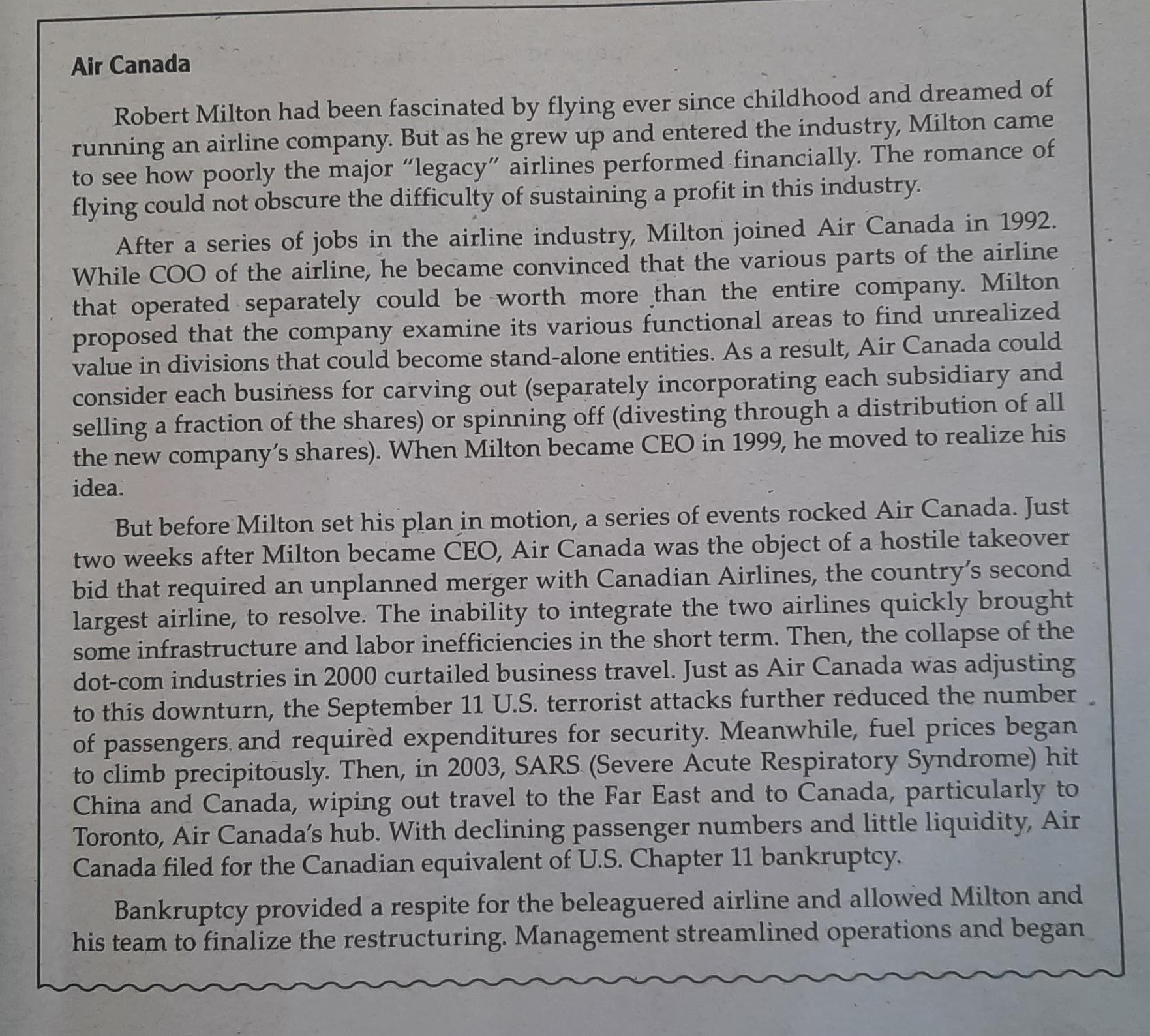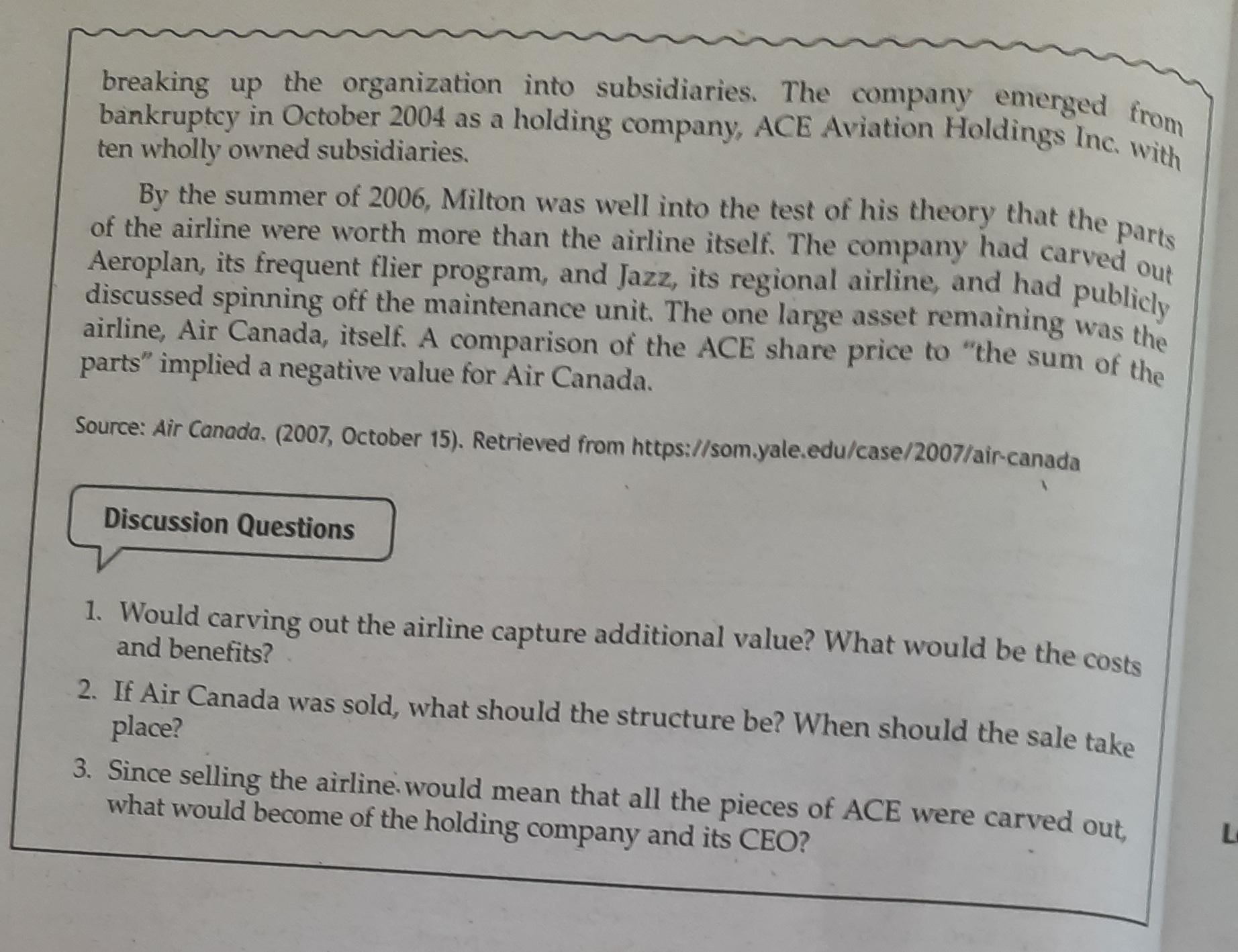Answered step by step
Verified Expert Solution
Question
1 Approved Answer
Air Canada Robert Milton had been fascinated by flying ever since childhood and dreamed of running an airline company. But as he grew up


Air Canada Robert Milton had been fascinated by flying ever since childhood and dreamed of running an airline company. But as he grew up and entered the industry, Milton came to see how poorly the major "legacy" airlines performed financially. The romance of flying could not obscure the difficulty of sustaining a profit in this industry. After a series of jobs in the airline industry, Milton joined Air Canada in 1992. While COO of the airline, he became convinced that the various parts of the airline that operated separately could be worth more than the entire company. Milton proposed that the company examine its various functional areas to find unrealized value in divisions that could become stand-alone entities. As a result, Air Canada could consider each business for carving out (separately incorporating each subsidiary and selling a fraction of the shares) or spinning off (divesting through a distribution of all the new company's shares). When Milton became CEO in 1999, he moved to realize his idea. But before Milton set his plan in motion, a series of events rocked Air Canada. Just two weeks after Milton became CEO, Air Canada was the object of a hostile takeover bid that required an unplanned merger with Canadian Airlines, the country's second largest airline, to resolve. The inability to integrate the two airlines quickly brought some infrastructure and labor inefficiencies in the short term. Then, the collapse of the dot-com industries in 2000 curtailed business travel. Just as Air Canada was adjusting to this downturn, the September 11 U.S. terrorist attacks further reduced the number of passengers, and requird expenditures for security. Meanwhile, fuel prices began to climb precipitously. Then, in 2003, SARS (Severe Acute Respiratory Syndrome) hit China and Canada, wiping out travel to the Far East and to Canada, particularly to Toronto, Air Canada's hub. With declining passenger numbers and little liquidity, Air Canada filed for the Canadian equivalent of U.S. Chapter 11 bankruptcy. Bankruptcy provided a respite for the beleaguered airline and allowed Milton and his team to finalize the restructuring. Management streamlined operations and began breaking up the organization into subsidiaries. The company emerged from bankruptcy in October 2004 as a holding company, ACE Aviation Holdings Inc. with ten wholly owned subsidiaries. By the summer of 2006, Milton was well into the test of his theory that the parts of the airline were worth more than the airline itself. The company had carved out Aeroplan, its frequent flier program, and Jazz, its regional airline, and had publicly discussed spinning off the maintenance unit. The one large asset remaining airline, Air Canada, itself. A comparison of the ACE share price to "the sum of the parts" implied a negative value for Air Canada. Source: Air Canada. (2007, October 15). Retrieved from https://som.yale.edu/case/2007/air-canada Discussion Questions 1. Would carving out the airline capture additional value? What would be the costs and benefits? 2. If Air Canada was sold, what should the structure be? When should the sale take place? 3. Since selling the airline would mean that all the pieces of ACE were carved out, what would become of the holding company and its CEO? L
Step by Step Solution
There are 3 Steps involved in it
Step: 1
1 Carving out the airline could potentially capture additional value for Air Canada if the different ...
Get Instant Access to Expert-Tailored Solutions
See step-by-step solutions with expert insights and AI powered tools for academic success
Step: 2

Step: 3

Ace Your Homework with AI
Get the answers you need in no time with our AI-driven, step-by-step assistance
Get Started


